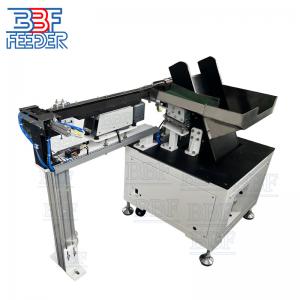
Add to Cart
PLC Step Feeder Large Capacity Steady Speed Nuts Feeding Machine
1 . Descriptions:
Industrial step feeders, also referred to as step feeder conveyors, are specialized material handling equipment extensively utilized in industrial automation and manufacturing. Their primary function is to transport and align parts or components with precision, ensuring that they are presented individually and correctly positioned at downstream machinery or assembly stations.
The name "step" is derived from their unique design that resembles a series of steps, facilitating the orderly movement of parts. Industrial step feeders offer several key features:
Part Orientation: These feeders align parts as they traverse the conveyor, guaranteeing their proper positioning for subsequent assembly, inspection, or packaging processes.
Sequential Feeding: Step feeders release parts one at a time, ensuring a controlled and consistent flow to the succeeding stages of manufacturing or assembly.
Adjustable Design: Many step feeders can be customized to handle parts of varying sizes, shapes, and weights, accommodating specific requirements.
Precision and Accuracy: Step feeders are engineered to operate with precision, minimizing the occurrence of jams, collisions, or misaligned parts during the feeding process.
Automation Integration: Step feeders are commonly integrated into automated manufacturing or assembly lines, working in conjunction with robots, conveyor systems, and other equipment to optimize production efficiency.
Versatility: Industrial step feeders have the capability to handle a wide range of parts, making them suitable for applications across diverse industries, including automotive, electronics, and medical devices.
Industrial step feeders play a vital role in scenarios that demand meticulous part orientation and sequential feeding. They ensure accurate delivery of parts to downstream machinery or assembly stations, contributing to enhanced efficiency, consistency, and productivity in manufacturing and assembly processes. Additionally, their utilization helps reduce the need for manual handling.
2 . Specifications:
| Product name | Step Feeder |
| Material | Aluminum(AL7075), Stainless Steel(SUS304) or Based on Customers' Requirements |
| Controller | CUH,Sanki,Sinfonia,REO,Afag |
| Voltage | 220V 50HZ/110V 60Hz or Based on Customers' Requirements |
| Power | 300W/500W/1000W/1500W/2000W |
| Package | Wooden Case Package |
| Speed | Based on Customers Requirements |
| Warranty | 2 Years |
| Certification | CE, ISO9001, ROHS |
| Lead Time | 3 Working Weeks |
3 . Choosing Between Stepper Feeders and Vibratory Bowl Feeders :
When deciding between stepper feeders and vibratory bowl feeders for your application, it's crucial to evaluate their unique features. Here are three key aspects to consider:
Setup: Stepper feeders offer precise customization of the step cycle using a variable frequency drive, ensuring it aligns with specific production cycle requirements. In contrast, vibratory bowl feeders rely on gravity and vibrations, which may necessitate adjustments to prevent parts from being thrown or dropped onto the tracks.
Part Integrity: Vibratory feeder tracks can be constructed from materials like stainless steel to maintain part integrity and meet sterility and durability standards. Additionally, soft material coatings can safeguard easily scratched parts. On the other hand, stepper feeders maintain part integrity through smooth motion without requiring parts to be dropped or thrown, thanks to the incorporation of an air system.
Noise Levels: Vibratory feeders can generate noise due to their metal tracks and steel design. To address this, a sound enclosure can be installed around the feeder bowl. In contrast, stepper feeders operate quietly due to their step operation and air system. Some models even feature rubber belt elevators, further reducing noise levels.
Considering these factors, along with other relevant considerations, will aid in determining the feeding system that offers the greatest advantages for your specific application when purchasing an electric feeder.
4 . More Pictures:


